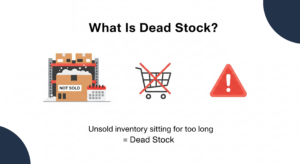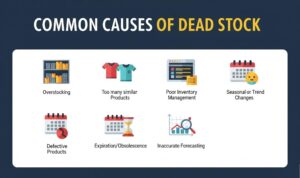What Is Dead Stock and How to Get Rid of It
Any store owner will tell you, that the pressure is on when it comes to deciding what products to stock as well as the various quantities. The reason for this is pretty simple, after all, if it doesn’t sell it becomes dead stock. As the name implies, the stock has no real-life left to give, it’s stuck.
And this is where every store owner’s worst nightmare comes to life. Let’s put it into perspective, shall we? You buy 20 boxes of ugly Christmas sweaters because everyone was looking for one the year before. Unfortunately, it’s now May and you’ve got 19 boxes of sweaters just taking up space in your storeroom.
This means that:
- Your storage space has been reduced
- The ability to order new stock is restricted
- You’re losing out on new opportunities and trends to follow
- Your customers will be looking for a store that doesn’t have tons of Christmas sweaters in storage.
Another example is canned goods. In the great shopathon that was the COVID-19 lockdown where people decided to stock up, you decided to over order non-perishable food items. Unfortunately, people are no longer bulk buying and you’re sitting with hundreds of cans of baked beans. And to make matters worse, they’re about to expire. How do you get rid of them without losing money? This is just one of many dead stock examples.

Why is dead stock bad for brands?
In case our previous examples didn’t paint a big enough picture the fact that 20-30% of most business stock becomes obsolete – and this applies to some of the most well-run businesses out there too. This means that it could be potentially more for less business savvy stores. No pressure.
Given this rather big number, it’s easy to see why dead stock is a problem and understand the need to find ways to effectively manage deadstock clearance.
Issues that arise as a result of deadstock include:
- Wasting warehouse space, and finding ways to improve warehouse efficiency needs to be considered.
- Increased overhead costs as you increase storage facilities to facilitate the dead stock.
- Additional staffing requirements to manage the excess stock and storage spaces.
- Longer lead times due to difficult to navigate storage spaces that may be spread out across the country – 19% of online shoppers will abandon their cart if delivery takes too long.
Common Causes of Dead Stock
There are so many reasons why brands end up with dead stock. To keep things simple, we’ll mention the four main causes of deadstock:

1. Over ordering: This could be because you anticipated a greater demand but lacked the customer interest in the product to drive sales the way that you had imagined.
2. Damaged goods: Whether it happened in transit or an unfortunate accident in the warehouse, goods can get damaged. If you cannot return them to the supplier, you’re stuck with defective products that people don’t want.
3. Expired goods: You could receive a bad batch, forget about a delivery or simply overorder. Unfortunately, this delay means that the expiration date could be fast approaching which is a problem.
4. Seasonal purchases: Much like the ugly Christmas sweaters mentioned before, some items are only applicable to certain times of the year, and once they’ve passed, so has the appeal of the item in question.
Dead stock vs Slow-moving and Excess Inventory – Are They the Same Thing?
No, they are not although they do share certain characteristics. Slow-moving products are products that are being sold, they’re just taking longer than expected to do so. Excess inventory is exactly as the name implies, you ordered too much of something and now it needs to stay in storage until the current stock starts moving.
Dead stock on the other hand could be excess inventory that was never sold or the by-product of slow-moving products. This stock is no longer moving, people are not interested in it and it’s simply taking up warehouse space.
To prevent dead stock from taking over, avoid ordering too much stock, and when in doubt, rather test the waters before bulk buying products. Your warehouse and bottom line will thank you for this.
11 Smart Ways to Get Rid of Dead Stock
The most obvious question that may be coming to mind is “How do you get rid of dead stock in luxury retail?”. The good news is that as terrifying as dead stock sounds, there are ways of working around it.
Without wasting any more time, let’s take a look at all the ways that you can get rid of dead stock, and free up space for more exciting products.
1. Charitable donations: One of the simplest ways of getting rid of unwanted stock is to partner with a charity. You’ll get a tax break and free up some much-needed warehouse space.
2. Do your research: Determine why there is no interest in the product and try to find a way to make it more appealing.
3. Return to sender: If possible, return the items to your supplier for a refund. Be sure to read the fine print before doing so.
4. Promotions: When in doubt, a good sale or promotion will do the trick in moving products while still earning a return in the process. People love good deals and free goods, so use this to your advantage.
5. Competitions: Much like promotions, the aim is to tap into the customer’s desire to get free things. So, create an awesome competition that comes with bragging rights, and watch it take off.
6. Repackaging: To try to gain interest from the consumer, consider rebranding the product if possible. Make it more appealing to the audience in question while standing out in a sea of options.
7. Re-sell it: You may not be having luck, but that doesn’t mean that other brands are having the same problem. Reach out to your peers to see if anyone would be interested in taking over the stock.
8. Partner up: Consider collaborating with another brand for a bundled offering, this targets a new audience which may help push the dead stock.
9. Expand your digital footprint: Try and list the product on third-party sites and marketplaces to reach a wider network.
10. Reach out to consignment stores: They’ll be able to find a use for your obsolete product and help your free up storage space in the process.
11. Liquidate: Some companies go around buying dead stock from businesses, it’s worth looking into those that operate in your area if things start to look dire.
Conclusion
The great news is that however bad deadstock may seem, it is preventable. And if it does happen to your business, there are so many ways of working around it. So, be smarter when it comes to your offering and don’t freak out when you experience dead stock, you can fix the problem.
Subscribe To Us
Contributors
Categories
Subscribe To Us
Contributors
Categories

This website uses cookies so that we can provide you with the best user experience possible. Cookie information is stored in your browser and performs functions such as recognising you when you return to our website and helping our team to understand which sections of the website you find most interesting and useful. Third party cookies such as Google Analytics is also used on this site to provide analytics in order to better understand the user engagement on our site.
You can adjust all of your cookie settings by navigating the tabs on the left hand side.
Strictly Necessary Cookie should be enabled at all times so that we can save your preferences for cookie settings.
If you disable this cookie, we will not be able to save your preferences. This means that every time you visit this website you will need to enable or disable cookies again.







0.Comments